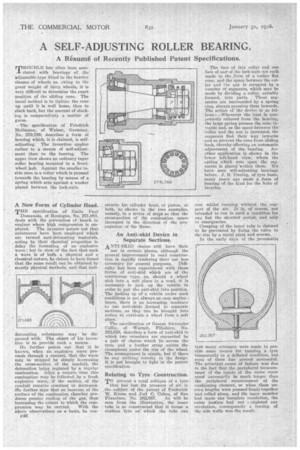A SELF-ADJUSTING ROLLER BEARING.
Page 68

If you've noticed an error in this article please click here to report it so we can fix it.
A Resume of Recently Published Patent Specifications.
MROT_IBLE bees often been asso-L ciated with bearings of the adjustable type fitted to the heavier classes of wheels as, owing to the great weight of lorry wheels, it is very difficult to determine the exact position of the sliding cone. The usual method is to tighten the cone tip until it is well home, then to slack back, but the amount of slacking is comparatively a matter of guess.
The specification of Friedrich Holimann, of Walzer, Germany, No. 279,789, describes a form of bearing which, it is claimed, is selfadjusting. The invention applies rather to a means of self-adjustment than to the bearing. The tippet view shows an ordinary taper roller bearing mounted in a frontwheel hub. Against the smaller inside cone is a collar which is pressed towards the bearing by means of a spring which acts against a washer placed between the leek-nuts.
A New Form of Cylinder Head.
TT-IF specification of Emile Paul Thunanois, of Boulogne, No 271,083, deals with the prevention of knock in engines where high compression is em ployed. The inventor points out that substances have been employed which are termed anti-detonating materials, acting by their chemical" Properties to delay the formation of an explosive wave; but in view of the fact that such a wave is of both a physical and a chemical nature, he claims to have found that the same result can be obtained by merely physical methods, and that anti detonating substances may be dis-: pensed with, The object of his invention is to provide such a means.
He further points out that it is known, when an explosive wave proceeds through a contact, that the -wave may be stopped by simply iricrensing the cross-section of the conduit, the detonation being replaced by a regular combustion. After a certain time this combustion may be followed by a fresh explosive wave,' if the section Of the conduit remains constant or'decreases. He further says that an increase of the eurface of the combustion chamber produces' greater cooling of the gas, thus increasing the extent to which the com
pression may be carried. With the above observations as a-basis, hecone40 streets his cylinder head, or piston, or both, as shoeva in the two examples, namely, in a series of steps so that the cross-section of the combustion space increases in the direction ef the propagation of the flame.
An Anti-skid Device in _ Separate Sections.
ANTI-SKID chains still have their
use in certain places, although the general improvement in road construction is rapidly rendering their use less necessary for general purposes. Difficulty has been experienced with those forms of anti-skid which are of the continuous type, as, should a wheel sink into a soft place in a road, it is necessary to jack up the vehicle in order to put the anti-skid into position. The jacking up of a vehicle under such • conditions is not always an easy matter ; hence, there is an increasing tendency to use anti-skide formed in separate sections, as they can be brought into action to extricate a wheel from a soft place.
The specification of George Alexander Collie, of Wormit, Fifeshire, No. 282,528, describes a form of anti-skid in which two crossbars are connected by a pair of chains which lie 'across the tyre, and a leather strap unites the crosspieces under the rim of the wheel. The arrangement is simple, but if there he any striking novelty in the design it is not brought to light in the patent specification.
Relating to Tyre Construction.
TO prevent a tetal collapse of a tyre that has lost its pressure of air is the subject of the patent of Frederick We Krone and Joel C. 'Cohen, of San
Francisco, No, 282,587. As will be seen from the illustration, the inner tube is so constructed that it forms a cushion tyre on which the tube can The face ,of this collar and one face of ond of the lock-nuts sip each made in tbeefeem of a rather flat cone, and the space between the and the nut is occupied by a number of segments, which may be made by dividing a collar, suitably formed, into parts. These segments are surrounded by a spring ring, always pressing them inwards. The action of the device is as follows :—Whenever the load is temporarily relieved from the hearing, the large spring presses the cone inwards and, as the space between the • collar and the nut is increased, the segmente find their way inwards and so prevent the cone from eliding back, thereby effecting an automatic adjustment of the bearing. Another application is shown in the lower left-hand view, where the spring which acts upon the segments is placed within them. We have seen self-adjusting bearings before. J. B. Dunlop, of tyre fame, many years ago made a farm of bearing of the kind for the hubs of bicycles.
tyre many attempts weee made to provide some means for running a tyre temporarily in a deflated condition, but none of them has proved successful. The principal .cause of failure was due to the fact that the peripheral measurement of the inside of the outer cover must necessarily be much longer than the peripheral measurement of the cushioning element, so when these uneven lengths were pressed firmly-together mod rolled along, and the inner member had made one complete revolution, the outer surface had not cempleted one revolution, consequently a tearing of ihe side walls was the result.












































































































